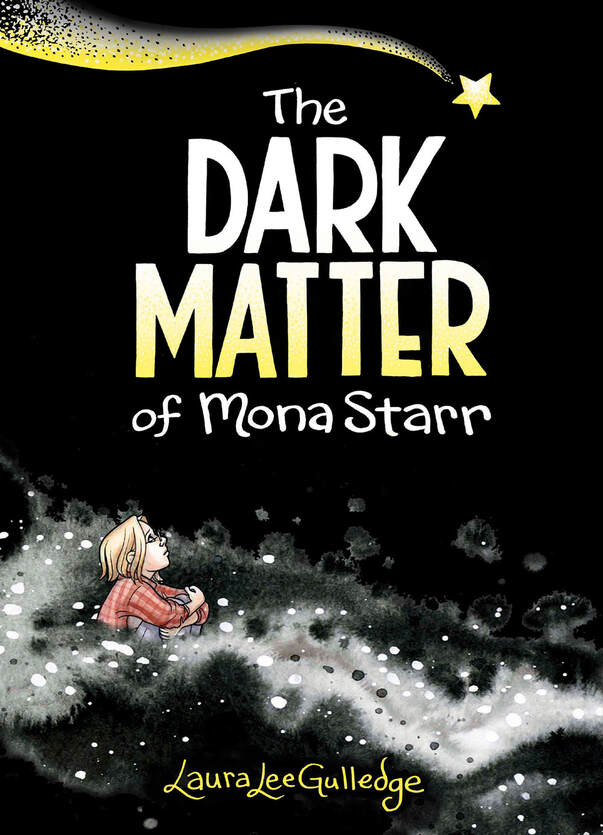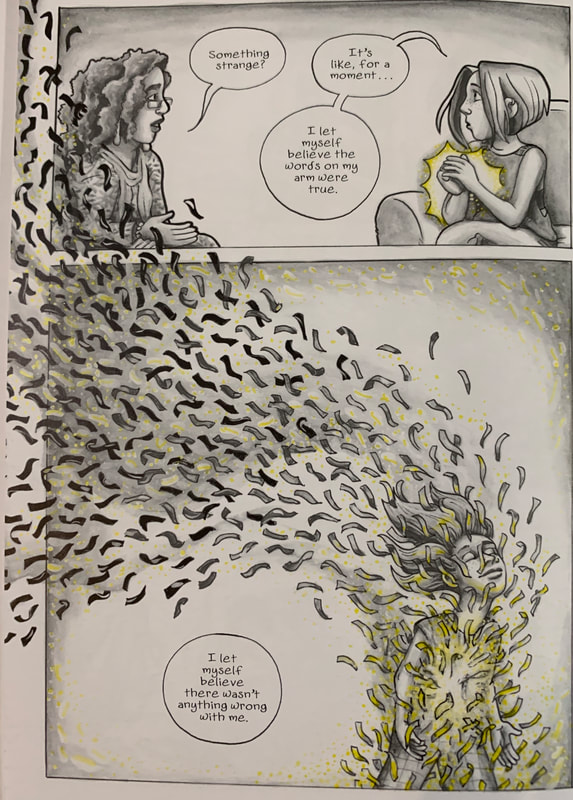|
The Dark Matter of Mona Starr. By Laura Lee Gulledge. Amulet Books/ABRAMS, 2020. ISBN 978-1419742002, $US14.99. 192 pages. In this semi-autobiographical novel, Mona, a high-schooler and artist who suffers from depression, undertakes a self-study to better understand her needs and triggers and fashion a "self-care plan." Though a loner by temperament, she learns to think outside of herself and recognize loving relationships and creative collaboration as important resources in her life. With the help of her counselor, parents, and friends, Mona chooses an ethic of community and participation, sharing her aesthetic gifts and inspiring others to do the same. Looking beyond herself, even as she honors her own needs, enables her to engage the world on different terms and, to some degree, counteract her depression. The novel climaxes with a community art project in which Mona and her self-styled "Artners," Aishah and Hailey, invite many of their fellow high-schoolers to collaborate in a spirit of loving community. The story's keynotes are self-love, self-advocacy, and willful optimism, and its last word (literally) is hope. Like Ellen Forney's celebrated memoir Marbles, this novel hovers between raw personal storytelling and hortatory self-help, with chapter headers that give emphatic advice, such as Turn emotion into action and Break your cycles. Author Gulledge shares her own self-care plan in the back pages, and her notes confirm that Mona Starr is indeed based on her. Artistically, the book is wildly expressive; the pages brim with visual metaphors of depression and elation, self-isolation and self-release, artistic engagement and pure joy. Depression, Mona's so-called dark matter (her mom is an astrophysicist), appears as swirling black clouds, faceless anthropomorphic demons, dark waters, black flames, and gripping hands. Moments of self-realization and delight are accompanied by stars and streaks of bright yellow: the one spot color in Gulledge's otherwise black-and-white, or rather grayscale, aesthetic. Mental landscapes — vast oceans, deep, dark wells, and the swirling cosmos — convey Mona's ever-shifting inner state. Consensus "reality" is perfused with expressionistic symbolism, and many pages leave behind real-world settings altogether. The sheer profusion of visual symbols reminds me of, say, Iasmin Omar Ata's Mis(h)adra (a semi-autobiographical account of epilepsy that is likewise braided with graphic devices signaling the protagonist's inner state). Gulledge's figures, word balloons, and symbols routinely break out of her panel grid — in fact, there is not one page that obeys a strict, unbroken paneling — and the layouts are ceaselessly dynamic. Immersive full bleeds are frequent. In short, the book is a staggering exercise in expressive drawing and page-making. Story-wise, though, Mona Starr feels a bit thin and undeveloped to me. Despite hints that other characters may also struggle with mental illness or disability, and despite the plot's emphasis on seeking "help" and community, the novel feels very much absorbed by Mona's mental state and Gulledge's exhortations to embrace one's creativity. The book feels idealized, dreamy, and self-involved; Gulledge's artistic bravura, the sheer busyness of her pages, doesn't let the depression seem real. Everything is couched in terms of artistic therapy, self-study, and a self-improvement "project." Mona's counselor is introduced at the start, before Mona's depression has manifested narratively, and the greater context is emphatically reassuring. Much of the book consists of poetic self-reflection, heightened by the overflow of visual metaphor, as if in confirmation of Mona's creative "genius" (a personality test labels her "the potentially unstable visionary type"). Familial and social complexity take second place to exploring Mona's state of mind through ravishing visuals. The singular focus on Mona's feelings and self-conception would probably be smothering in bare prose; only Gulledge's ecstatic imagery gives the story life and depth. The result is heady and interesting but, I'm tempted to say, less novelistic than an exercise in didactic self-help. Somehow, the book manages to be at once lyrical, spectacular, and a confidently crafted exercise in comics, yet also frustratingly under-done, as if Gulledge couldn't quite take distance from what is, after all, a kind of exhortative autofiction. But here's the deal: I enjoyed reading Mona Starr, and it has moments that, on re-reading, still get me choked up. The book's conclusion is calming and gratifying, and I cannot deny Gulledge's hard-won insight. I am pretty sure that some readers will be affirmed, and perhaps even forever changed, by reading this book. I wouldn't recommend Mona Starr for complex, intersubjective storytelling, but will remember its powerful evocations of feelings and states of mind, as well as Gulledge's confident artistry.
0 Comments
Your comment will be posted after it is approved.
Leave a Reply. |
Archives
June 2024
|



 RSS Feed
RSS Feed
